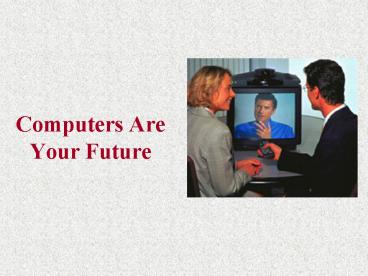Computers Are Your Future - PowerPoint PPT Presentation
1 / 28
Title:
Computers Are Your Future
Description:
Computers Are Your Future. 2. Computers Are Your Future Chapter 3 ... Picture messaging using camera phones to send pictures to other cell phones. 28 ... – PowerPoint PPT presentation
Number of Views:79
Avg rating:3.0/5.0
Title: Computers Are Your Future
1
Computers Are Your Future
2
Computers Are Your Future
- Chapter 3
- Wired and Wireless Communication
3
What You Will Learn . . .
- The definition of bandwidth
- The bandwidth needs of a typical user
- How modems change digital signals into analog
- Transmission media and methods
- Limitations of public switched telephone network
(PTSN) for sending and receiving data
4
What You Will Learn . . .
- Multiplexing and digital telephony and their
impact on line usage - Examples of how digitization and convergence are
blurring the boundaries between popular
communication devices - Various wired and wireless applications
5
Connectivity
Connectivity
the ability to link various media and devices
6
Moving Data Bandwidth and Modems
- Communications sending and receiving messages
- Communications channels paths through which
messages are passed - Signals can be
- Analog data is in continuous waveforms
- Digital data is in discontinuous pulses (0s
1s)
digital
analog
7
Moving Data Bandwidth and Modems
- Bandwidth the amount of data that can be
transmitted through a given communications
channel - Analog measured in cycles per second (Hz)
- Digital measured in bits per second (bps)
- Broadband any transmission medium that
transports high volumes of data at high speeds
8
Moving Data Bandwidth and Modems
- Modems
- Transmit data over telephone lines
- Modulation converts digital (from computer) to
analog to cross telephone lines - Demodulation converts analog (phone lines) to
digital for computer
9
Wireless Transmission Media
- Wireless transmission media refers to the methods
of carrying data through the air or space using
infrared, radio, or microwave signals
10
Wireless Transmission Media Twisted Pair
Twisted Pair two insulated wires twisted around
each other used for telephone wires
11
Wireless Transmission Media Coaxial Cable
- Coaxial Cable center copper wire surrounded by
insulation, surrounding a layer of braded wire
12
Wireless Transmission Media Fiber Optic
Fiber-optic cable thin strands of glass that
carry data by light pulses
13
Wireless Transmission Media Infrared
- Infrared is a wireless transmission medium that
carries data via light beams - Transmitter and receiver must be in line of sight
- An IrDa port is needed to use infrared with a
computer
14
Wireless Transmission Media Radio
- Radio is a wireless transmission medium that
carries data via radio frequency signals - Wireless LANs in a home or business are one type
of radio technology - Radio signals can be long range (between cities
or regions) and short range (within a building) - Radio signals are susceptible to noise and
electrical interference
15
Wireless Transmission Media Bluetooth
- Short-range radio transmission technology
- Devices identify each other by identification
number - Connection is confirmed before it is made final
- Does not require a line of site
16
Wireless Transmission Media Microwaves
- Microwaves are high-frequency radio waves
- Much of long-distance telephone service is
carried by microwaves - Microwaves travel in a straight line
- Microwave relay stations are built about 30 miles
apart
17
Wireless Transmission Media Satellites
- Satellites are microwave relay stations suspended
in space - They are positioned in geosynchronous orbits
- Satellites use microwave signals to transmit data
to and from earth-based microwave relay stations
18
Wired Communication via the PSTN
- The public switched telephone network (PSTN) is
the world telephone system - It is used for data as well as voice
communications - Twisted-pair wire and fiber-optic cable provide
the connections for the system - Home and business phones are connected to
subscriber loop carriers (SLCs) - The area serviced by SLCs is called the local loop
19
Convergence Is it a Phone or a Computer?
- Digitization transformation of data into
digital form - Convergence merging of disparate objects or
ideas into new combinations
20
Cellular Telephones
- Cellular telephones enable calls to be placed
through a wireless telecommunications system - Cellular phones use radio or infrared signals
- Cells are limited geographic transmission areas
- A mobile telephone switching office (MTSO)
monitors the signal strength of cellular phones
21
Personal Communication Service (PCS)
- Personal Communication Service (PCS) refers to
digital cellular telephone service technologies - Digital cellular phones offer
- Noise-free sound
- Improved coverage
- Protection from eavesdropping and phone fraud
- Voice recognition
- High-speed Internet access
22
Web-Enabled Devices
- A Web-enabled device is any device that can
display and respond to HTML or XML - PDAs, cell phones, and tablet PCs are Web-enabled
devices
23
Wired and Wireless Applications
- Internet telephone using the Internet for
real-time voice communications
24
Wired and Wireless Applications
- Videoconferencing using sound and video
technologies to meet with others
25
Facsimile (Fax) Transmission
- Fax transmission is the means of sending an image
of a document over telephone lines - Fax modems support fax as well as data protocols
26
Satellite Radio, GPS
- Satellite radio - broadcasts are transmitted
through a satellite - GPS global positioning systems
- 27 earth orbiting satellites
- Navigation systems
27
Text, Picture, and Video Messaging
- Text messaging sending text communications over
a cell phone - Picture messaging using camera phones to send
pictures to other cell phones
28
Chapter 3 Summary
- Bandwidth is the data transfer capacity of a
communication channel - A modem is used to send digital data over a phone
line - Physical and wireless media are used to
communicate with technology - The public switched telephone network (PSTN) is
mostly digital - Internet telephony and faxing can be accomplished
through the Internet































